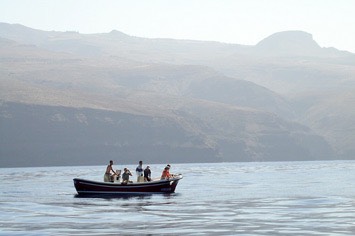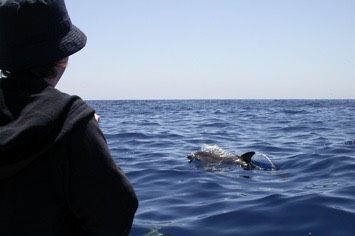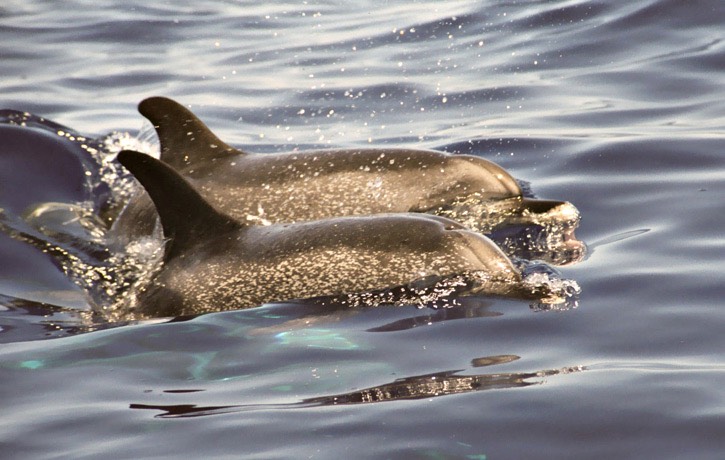In May 2003 we decided on short notice to celebrate Mick's birthday away from home. An ideal place to go for sunshine, good food and plenty of dolphins seemed to be La Gomera, one of the smaller of the Canary Islands. We booked a flight to Tenerife and took the ferry from there. En route we saw the first group of short-finned pilot whales, which barely managed to escape from the track of our fast ferry. On Gomera, we hired a car and headed towards the little harbour of Vueltas in the Valle Gran Rey, where we easily managed to rent a room for the week.


On Mick's birthday we embarked on a long boat trip around the southern coast of the island to enjoy the scenery and try our luck with the dolphins. And lucky we were - a small group of bottlenose dolphins (Tursiops truncatus) briefly approached the vessel, allowing us to take a stunning photo of a surfacing dolphin, where you can even see his eye!

After this first success, we went on two whale and dolphin watching tours over the next few days. The trips were made in traditional fishing boats which never carried more than six passengers, allowing for some space to move around and get a good view.


On both trips we encountered small groups of rough-toothed dolphins (Steno bredanensis), which was an exciting find as they are not seen on all trips. In this species, individuals always surface closely side by side, with their sloping foreheads clearly visible. They are the only dolphin species with a melon shaped like this, which gives them a somewhat reptilian or pre-historic look.






If one isn't lucky enough to bump into dolphins, than it is always a good idea to follow the seabirds. When we approached a large flock of Cory's shearwaters, we could make out the shapes of dolphins feeding underneath from quite a distance. As soon as we drew closer, several dolphins tore themselves away and rushed over to investigate our two boats.








They turned out to be Atlantic spotted dolphins (Stenella frontalis), which are very often ready to investigate and accompany any boats they encounter. This lot was very happy to surface all around us and bow-ride the boats as soon as they slowly moved forwards.






Atlantic spotted dolphins get their name from the white spots that develop when the animals mature. The older the dolphin is, the more white spots it sports.



Juveniles and immature animals on the other hand have no or only very few spots, so in any one group one can always find many rather plain looking dolphins that are easily confused with the similar but more robust bottlenose dolphins.





Unfortunately, we didn't encounter any more short-finned pilot whales (Globicephala macro-rhynchus), but we did catch a distant glimpse of a male Cuvier's beaked whale (Ziphius cavirostris). Going out in the small, traditional boats and getting really up close to the dolphins was a special experience and we can thoroughly recommend La Gomera as a whale watching destination!